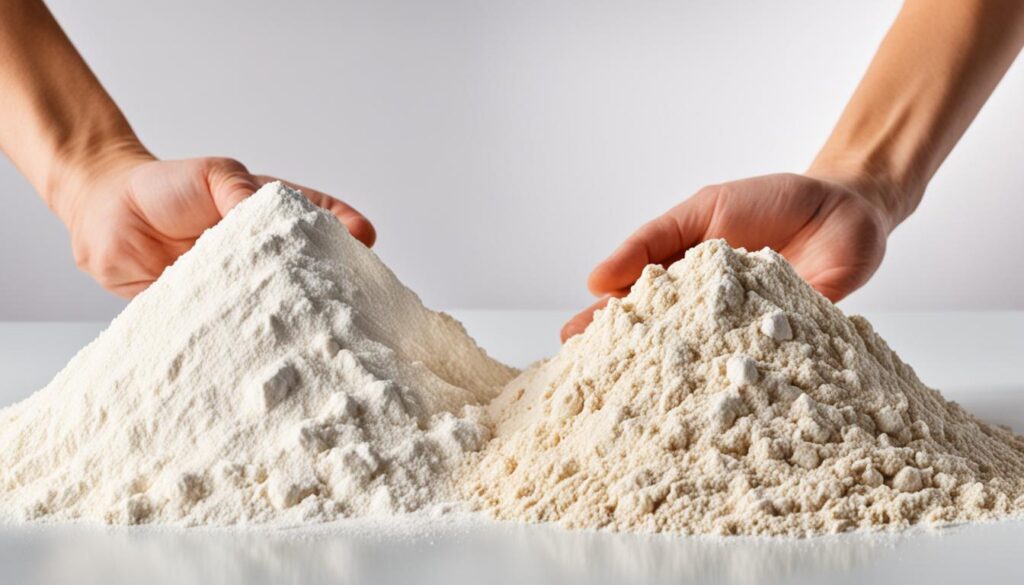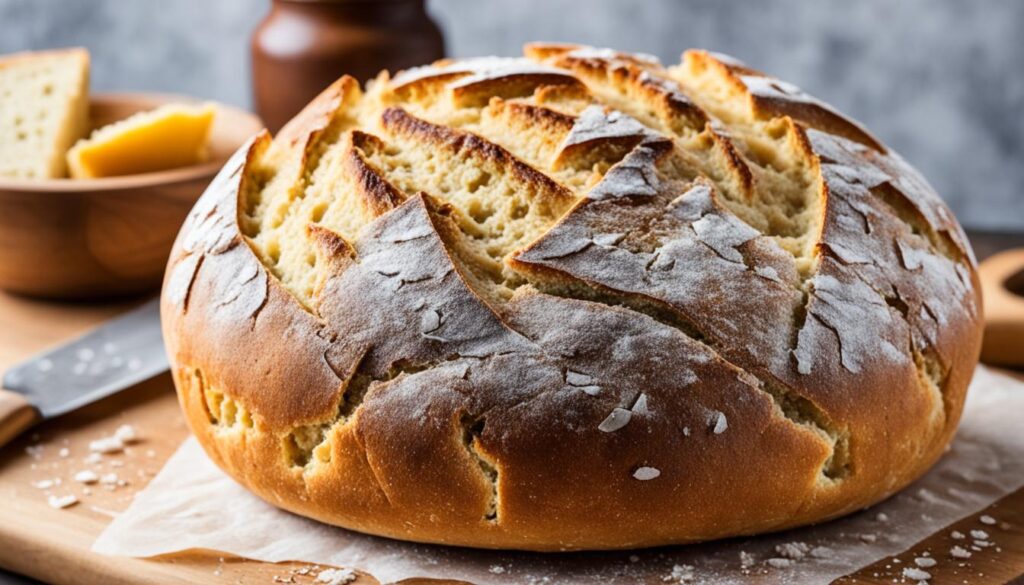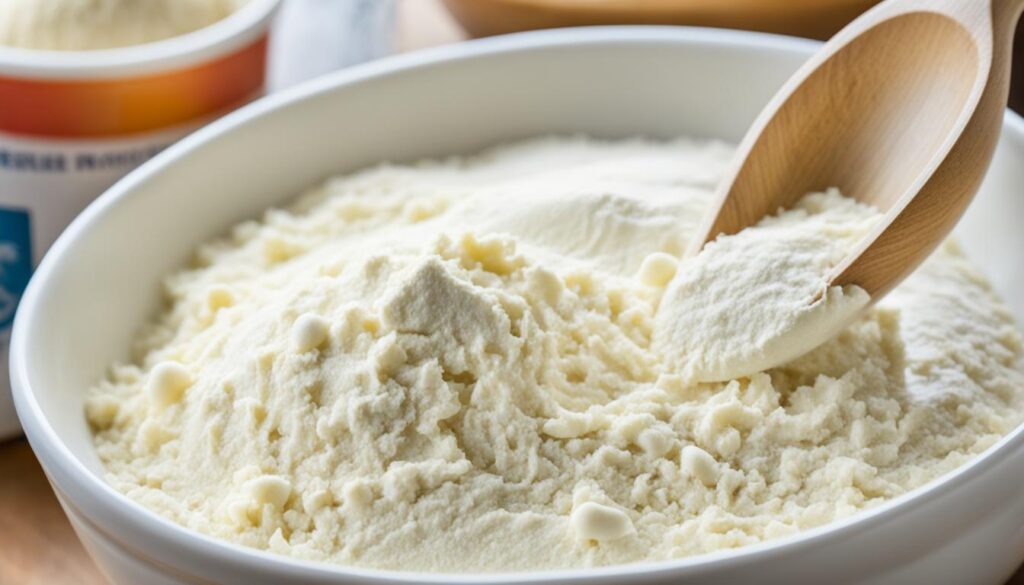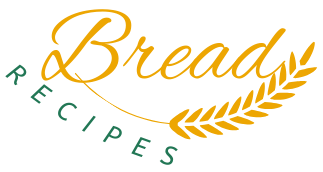Have you ever craved the comforting aroma of freshly baked bread wafting through your kitchen? The kind that conjures memories of warm family gatherings and cozy Sunday mornings? I know I have. And as someone with dietary restrictions, finding a vegan and gluten-free bread that satisfies both my taste buds and my health needs seemed like an impossible quest.
That is, until I discovered the magic of homemade vegan gluten-free bread. It’s a revelation that not only allows me to indulge in my passion for baking but also provides a delicious solution for those who follow a plant-based, gluten-free, or dairy-free lifestyle. So today, I’m excited to share with you my easy, foolproof recipe that will bring the joy of freshly baked bread back into your life.

But before we dive into the details, let’s talk about the benefits of making your own gluten-free vegan bread. Firstly, it gives you complete control over the ingredients, ensuring that each slice is packed with wholesome goodness. No more artificial additives or hidden preservatives – just pure, nourishing ingredients that are kind to both your body and the planet.
Secondly, baking your own bread allows you to unleash your creativity in the kitchen. From experimenting with different flour blends to adding your favorite seeds and nuts for extra crunch and flavor, the possibilities are endless. Not to mention the satisfaction of slicing into a warm loaf that you created with your own two hands.
So, whether you’re a gluten-free guru, a vegan virtuoso, or simply looking for a healthier alternative to store-bought bread, this easy gluten-free vegan bread recipe is for you. Get ready to experience the joy of homemade bread that’s as hearty as it is healthy, and as delicious as it is delightful.
Table of Contents
The Quest for the Perfect Vegan Gluten Free Bread Recipe
Baking vegan and gluten-free bread can be a challenging quest. It requires finding alternatives to both gluten and animal products, which are commonly used as structure and binding agents in traditional bread recipes. However, with the right ingredients and techniques, you can create a delicious loaf that is both vegan and gluten-free.
The Challenges of Baking Without Gluten and Animal Products
When baking gluten-free bread, the absence of gluten poses a challenge as it is responsible for the elasticity and rise in traditional bread. Without gluten, gluten-free bread tends to be dense and crumbly. Additionally, when baking vegan bread, the lack of eggs can make it difficult to achieve a light and airy texture. However, with a few adjustments and substitutions, these challenges can be overcome.
Discovering the Magic of Psyllium Husk Powder
One ingredient that can work wonders in vegan gluten-free baking is psyllium husk powder. Psyllium husk powder acts as a binding agent, creating structure in the bread and allowing it to rise. It absorbs liquid and forms a gel-like consistency, mimicking the effects of eggs in traditional recipes. The result? A light and fluffy vegan gluten-free bread that holds together beautifully.
Psyllium husk powder is derived from the seeds of the Plantago ovata plant. It is high in soluble fiber and is often used as a natural remedy for digestive health. In the context of baking, psyllium husk powder adds moisture and helps improve the texture of gluten-free bread. It is a game-changer for those seeking to create vegan gluten-free bread that rivals its traditional counterparts.
To fully understand the benefits of psyllium husk powder in vegan gluten-free baking, let’s explore the recipe and ingredient details in the next section.
Vegan Gluten Free Bread Recipe: Ingredients and Substitutes
To create the perfect vegan gluten-free bread, it’s important to understand the key ingredients and substitutes that will make your bread both delicious and accommodating to dietary restrictions. Let’s dive into the world of flour blends and the essential role of psyllium husk powder.
Navigating Through Different Flour Blends
When it comes to gluten-free baking, finding the right flour blend is crucial. Not only does it provide structure and texture to your bread, but it also affects the taste and overall quality of the final product. Here are some popular flour options and their substitutes:
| Flour Blend | Substitute |
|---|---|
| Almond flour | Coconut flour |
| Brown rice flour | Buckwheat flour |
| Tapioca flour | Arrowroot flour |
| Quinoa flour | Millet flour |
Note: Experiment with different flour combinations to find the blend that suits your taste preferences and dietary needs the best.
Essential Role of Psyllium Husk Powder
Psyllium husk powder is a game-changer when it comes to vegan gluten-free baking. It acts as a binder and helps create structure and texture in your bread. This natural fiber source absorbs moisture, creating a dough that is easier to work with and results in a light and airy texture. Additionally, psyllium husk powder adds a nutritional boost to your bread, aiding digestion and promoting a healthy gut.
When using psyllium husk powder, it’s crucial to follow the recipe closely, as too much or too little can impact the texture and consistency of your bread. Typically, a ratio of 1-2 teaspoons of psyllium husk powder per cup of flour is recommended, but always refer to the specific recipe for precise measurements.
So, next time you embark on your vegan gluten-free bread baking adventure, don’t forget to explore different flour blends and embrace the magic of psyllium husk powder. These ingredients will ensure that your bread is not only delicious but also a wholesome addition to your plant-based lifestyle. Happy baking!
| Benefits of Homemade Gluten-Free Vegan Bread |
|---|
| 1. Control over ingredients and quality |
| 2. Cost savings compared to store-bought options |
| 3. Customization options to suit individual tastes |
| 4. Freshness and aroma of homemade bread |
| 5. Avoidance of allergens and dietary restrictions |
Revolutionary No-Yeast, Egg-Free Bread Baking
If you’ve ever wondered why yeast and eggs are commonly found in bread recipes, we’re about to embark on an exciting journey that will revolutionize your baking experience. In this section, we’ll explore the fascinating world of no-yeast and egg-free bread baking, revealing the advantages of using substitutes like psyllium husk powder to create delicious vegan gluten-free bread.
Why Yeast and Eggs are Common in Bread
Historically, yeast has been a fundamental component in bread making. It acts as a leavening agent, causing the dough to rise and creating the light, airy texture we associate with freshly baked bread. Eggs, on the other hand, provide structure, moisture, and enhance the flavor of the bread. However, for individuals following a vegan or egg-free diet, finding suitable alternatives is crucial for enjoying homemade bread.

“Baking is like love. It should be entered into with abandon or not at all.” – Harriet Van Horne
How Psyllium Husk Replaces Traditional Bread Binders
Enter psyllium husk powder, a game-changing ingredient in the world of vegan gluten-free bread baking. Derived from the seeds of the Plantago ovata plant, psyllium husk acts as a natural binder and provides the necessary structure, texture, and elasticity to your bread. When combined with water, psyllium husk forms a gel-like consistency that mimics the role eggs play in traditional bread recipes.
Psyllium husk powder brings many benefits to your bread baking adventures. Not only does it help hold the ingredients together, but it also adds moisture, enhances shelf life, and improves the overall texture of your loaf. Additionally, psyllium husk is a rich source of dietary fiber, which promotes gut health and aids digestion.
By utilizing psyllium husk powder as a substitute for eggs and yeast, you can confidently create enticing loaves of no-yeast, egg-free bread that surpass your expectations in both taste and texture.
| Traditional Bread Ingredients | No-Yeast, Egg-Free Bread with Psyllium Husk Powder |
|---|---|
| Yeast | No yeast required |
| Eggs | Psyllium husk powder acts as a natural binder |
| Flour | Gluten-free flour blends |
| Flavor | Incredible flavor without eggs or yeast |
| Texture | Light, airy, and perfectly moist |
Customizing Your Vegan Gluten Free Loaf with Seeds and Nuts
One of the great things about baking your own vegan gluten-free bread is the ability to customize it according to your taste preferences. By adding seeds and nuts to the recipe, you can enhance the flavor and texture of your loaf. Here are some options to consider:
Incorporating Pumpkin Seeds for a Nutty Flavor
Pumpkin seeds are a fantastic addition to your vegan gluten-free bread. Not only do they add a delightful nutty flavor, but they also provide a boost of nutrients and a satisfying crunch. Simply mix them into the dough before baking and enjoy the delicious results.
Options for Adding Sunflower, Sesame, or Chia Seeds
If you’re looking for more variety, consider adding sunflower, sesame, or chia seeds to your bread. Sunflower seeds can add a subtle nuttiness, while sesame seeds bring a toasty flavor. Chia seeds, on the other hand, offer a dose of omega-3 fatty acids and a slight crunch. You can sprinkle these seeds on top of the loaf before baking or mix them into the dough for a more evenly distributed texture.
The versatility of the vegan gluten-free bread recipe allows you to experiment with different combinations of seeds and nuts to create a loaf that perfectly suits your taste buds. Whether you prefer a richer flavor with pumpkin seeds or enjoy the gentle crunch of sunflower, sesame, or chia seeds, customization options are endless.
With the addition of seeds and nuts, your vegan gluten-free bread will not only be delicious but also packed with extra nutrients and flavors. So go ahead and get creative with your customization options to elevate your bread baking game!
Gluten Free Baking: Measuring Success Beyond Cups
When it comes to gluten-free baking, accuracy in measuring ingredients is key to achieving delicious and consistent results. While many traditional recipes rely on cup measurements, gluten-free baking requires a more precise approach. In this section, we’ll explore alternative measurement techniques and provide useful tips to help you measure success in your gluten-free baking endeavors.
One valuable technique in gluten-free baking is to weigh your ingredients. This ensures precise measurements and helps maintain the right balance of wet and dry ingredients. Investing in a kitchen scale can greatly improve your baking outcomes and eliminate any guesswork. By following weight measurements instead of relying solely on volume, you’ll have more control over the texture and structure of your gluten-free treats.
Another useful method is to incorporate visual cues into your measuring process. Paying attention to details such as the texture of the dough or the consistency of the batter can be a reliable indicator of whether your gluten-free creation is on the right track. Adjustments can then be made accordingly to achieve the desired results.

“In gluten-free baking, accurate measurements lay the foundation for success. By implementing weight measurements and using visual cues, you can ensure each creation exceeds expectations.”
Additionally, consider using reliable measuring tools such as graduated measuring cups, spoons, and kitchen timers to maintain consistency throughout the baking process. These tools will help you accurately measure ingredients and keep track of baking times, contributing to your success in achieving gluten-free perfection.
Lastly, don’t be afraid to experiment and adapt recipes to suit your preferences. Gluten-free baking offers endless possibilities for creativity and innovation. Feel free to incorporate new flavors, textures, and techniques to make your gluten-free treats truly unique and memorable.
In conclusion, accurate measurements are crucial in gluten-free baking. By leveraging alternative measurement techniques, such as weighing ingredients and using visual cues, you can elevate your gluten-free creations to new heights. So grab your measuring tools, unleash your creativity, and embark on a gluten-free baking adventure like no other!
How to Storage and Extend the Freshness of Your Vegan Bread
Properly storing your vegan gluten-free bread is essential for maintaining its freshness and taste. By following these storage tips, you can ensure that your bread stays delicious for longer periods of time.
Freezing for Longevity: The Proper Way to Store Bread
If you’re not planning to consume your vegan gluten-free bread within a few days, freezing is a great option to extend its shelf life. Here’s how to freeze your bread properly:
- Allow the bread to cool completely before freezing to avoid condensation.
- Wrap the bread tightly in plastic wrap or place it in a sealed freezer bag to prevent freezer burn.
- Label the package with the date to keep track of its freshness.
- Place the bread in the freezer, ensuring it is in an upright position to prevent deformation.
When you’re ready to enjoy your frozen bread, simply remove it from the freezer and let it thaw at room temperature. To preserve its texture and taste, avoid defrosting it in the microwave.
Reviving Your Gluten Free Vegan Bread: Toasting Tips
If your vegan gluten-free bread has become stale, toasting it can bring it back to life. Follow these toasting tips for a rejuvenated bread experience:
- Slice the bread to your desired thickness.
- Preheat your toaster or oven to the desired level of toasting.
- Place the bread slices in the toaster or on a baking sheet in the oven.
- Toast the bread until it reaches a golden brown color and has a crispy texture.
- Remove the toasted bread from the toaster or oven and let it cool slightly before enjoying.
Toasting your gluten-free vegan bread not only restores its freshness but also adds a delightful crunch and flavor to each bite.
By properly storing your vegan gluten-free bread and using toasting as a revitalizing technique, you can enjoy fresh and delicious bread for longer periods of time. Take advantage of these storage and preservation methods to make the most out of your homemade gluten-free bread.
Exploring More Vegan and Gluten Free Recipes Beyond Bread
Now that you’ve mastered the art of baking your own vegan gluten-free bread, it’s time to expand your culinary horizons and explore a world of delicious plant-based and gluten-free recipes. Whether you’re looking for dairy-free alternatives, easy gluten-free meals, or healthy plant-based options, there are countless recipes to try that will satisfy your taste buds and nourish your body.
One great resource for finding vegan gluten-free recipes is Minimalist Baker. Known for their simple and flavorful recipes, they offer a wide variety of dishes that are both gluten-free and vegan-friendly. From scrumptious pasta dishes to mouthwatering desserts, Minimalist Baker has something for every meal and occasion.
If you’re in the mood for some dairy-free inspiration, check out the Oh She Glows cookbook by Angela Liddon. This New York Times bestseller is packed with plant-based recipes that are not only dairy-free but also gluten-free. With Angela’s creative and delicious recipes, you’ll never feel like you’re missing out on anything.
For those who prefer easy and quick gluten-free meals, look no further than Gimme Some Oven. This popular food blog offers a variety of gluten-free recipes that can be made in 30 minutes or less. From flavorful stir-fries to hearty soups, Gimme Some Oven has your busy weeknight dinners covered.
Now that you have a range of resources to explore, go ahead and experiment with new flavors and ingredients. Whether you’re looking for savory meals or delectable desserts, the world of vegan and gluten-free cooking has so much to offer. So, get into the kitchen, put on your apron, and let your creativity shine!
✅ Quick Tips: Read the recipe in its entirety before you start cooking. This will help you understand the ingredients, steps, and timing involved, and allow you to prepare any necessary equipment or ingredients beforehand.
Easy Vegan Gluten Free Bread Recipe
Description
Satisfy your cravings with this fragrant, gluten-free bread infused with savory herbs and a hint of garlic. Perfect for sandwiches or to accompany a hearty soup.
Ingredients
Vegan Gluten Free Bread Ingredients
Instructions
Vegan Gluten Free Bread Instructions
-
Dissolve yeast in warm water, let sit for 5 minutes.
In a small bowl, whisk together yeast and the wet ingredients in the warm water.
-
Mix in olive oil, salt, herbs, and garlic powder.
In a large mixing bowl, combine the gluten-free flour blend, psyllium husk powder, salt, and any additional dry ingredients you want to incorporate, such as herbs or spices.
-
Gradually add flour, knead until smooth.
Pour the wet ingredients into the dry ingredients and stir until a sticky dough forms.
-
Let rise in a warm place for 1 hour.
-
Shape dough into a loaf, let rise for 30 minutes.
-
Bake at 375°F for 25-30 minutes.
Once baked, remove the bread from the oven and let it cool in the pan for about 10 minutes. Then, transfer it to a wire rack to cool completely before slicing.
-
Cool and enjoy
Enjoy your homemade gluten-free vegan bread as is, or customize it further by toasting slices, using it as a base for sandwiches, or adding your favorite spreads and toppings.
Nutrition Facts
Servings 8
- Amount Per Serving
- Calories 114kcal
- % Daily Value *
- Total Fat 2.8g5%
- Saturated Fat 0.39g2%
- Trans Fat 0.4g
- Total Carbohydrate 19g7%
- Dietary Fiber 1g4%
- Protein 3.2g7%
* Percent Daily Values are based on a 2,000 calorie diet. Your daily value may be higher or lower depending on your calorie needs.
Note
Making your own bread allows you to control the ingredients, ensuring a healthier and tastier option compared to store-bought alternatives. Plus, it's a cost-effective solution that allows for endless customization possibilities to suit your preferences.




Finally, a bread recipe that aligns with my vegan and gluten-free lifestyle!